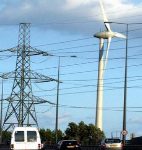Editor’s note: Prospects for significant progress towards a new global deal at UN-led climate-change talks in Durban, South Africa, look gloomy. But in the absence of the global agreement that was hoped for at the Copenhagen conference in December 2009, many countries are developing ambitious climate goals on their own. One such country is the host of the COP15 conference itself, namely Denmark.
Last year, the Danish Commission on Climate Change Policy found that Denmark can remove fossil fuels entirely from its energy system, including transport, by 2050 – without introducing nuclear energy or carbon capture and storage. In response, the Danish government immediately adopted the goal of becoming independent of fossil fuels by 2050. Removal of fossil fuels would bring Denmark in line with the EU policy goal of reducing greenhouse gas emissions by 80% to 95% by 2050. In September, 2011, a new government came into power with even more ambitious goals for the short term, i.e, 50% of electricity from wind in 2020 and complete removal of fossil fuels from the electricity and energy sectors by 2035.
The commission report’s recommendations are specific to the current Danish situation, but its authors claim the same approach can be used by other nations. Significantly, the overall cost of achieving fossil fuel independence, it found, is only marginally more (on the order of 0.5% of GDP in 2050) than predicted total energy-related expenditure in a “business-as-usual” scenario. This near equivalence in cost is due primarily to expected increases in the price of fossil fuels.
Here, in an edited, two-part version of a longer peer-reviewed article that appeared in Solutions journal, Katherine Richardson outlines the road map for Danish fossil-fuel independence.
The Danish Commission on Climate Change Policy reported in 2010 that Denmark could be independent of fossil fuels by 2050, with a greenhouse-gas emission reduction on the order of 80% compared to 1990 emissions. The commission defined independence from fossil fuels as: no use of fossil fuels for energy in Denmark. Import of energy based on fossil fuels was allowed, but the total amount of renewable energy produced in Denmark must, as a yearly average, be at least equal to Danish energy demands.
According to data from 2009, the most recent available, renewable energy sources supply 18% of gross energy production in Denmark, with biomass being, by far, the largest contributor. Approximately 3% of the gross energy supply comes from wind, while approximately 20% of the electricity is produced from wind power. Nevertheless, the commission concluded that it is realistic to assume that 100% of Denmark’s energy needs in 2050 can be covered by electricity generated from renewable sources, such as wind, solar, geothermal and wave. The commission’s relatively optimistic assessment is based on an assumption of significant technological development with respect to both electric vehicles and “smart grids” (energy systems that can defer some degree of energy demand to periods when excess energy is produced).
Abundant wind energy resources, particularly offshore, and relatively large per capita biomass resources compared to other European Union countries could likely provide the basis of the future, fossil fuel-free energy sector. The role of other energy sources—solar, geothermal, wave—will depend on their possible development to commercial viability. Energy production in the future will largely be based on fluctuating sources, thus requiring a degree of flexibility on the demand side (i.e., “smart grids” and “intelligence” in energy demand).
Considerable investment in new infrastructure will be required and energy will, regardless of its source, become more expensive than it is today. However, infrastructure investment will also be necessary with continued dependence on fossil fuels and fossil fuels will become more expensive over time. Given this, the model calculations carried out for the commission show that the difference between energy costs for Denmark in phasing out fossil fuels, compared to those where present energy forms are continued until 2050, is likely to be less than 1% of gross domestic product (GDP).
The commission’s analyses suggest that Denmark has access to wind resources in excess of its projected 2050 energy demands, but that 100% reliance on wind power would not be possible without significant technological development in energy storage. Therefore, the only limitation to incorporating wind in the new energy system appears to be the current technical capacity to accommodate a fluctuating energy source such as wind in the system.
Biomass resources in Denmark are, on the other hand, estimated to be insufficient to meet the projected 2050 energy demand. Assuming present levels of food production are maintained, potential domestic biomass resources (including waste) would only cover some 25% of present gross energy consumption and, at best, less than 50% of the projected 2050 demand. (Unless otherwise stated, energy supply/demand/consumption refers throughout this article to gross energy.) Furthermore, the potential limits on the sustainable production of biomass globally are currently unknown. Therefore, the commission analysed the consequences for the Danish energy system using different assumptions concerning the amount of biomass available for energy purposes.
Greater energy efficiency is an important part of the strategy for independence from fossil fuels, as it is the key to minimising the costs of transformation. Infrastructure investment comprises the major cost of becoming independent of fossil fuels. These costs are held at a minimum if production of energy is designed to meet that actual energy demand, rather than an artificially high demand. On the basis of existing studies concerning the cost effectiveness of energy-efficiency investment and historical trends in efficiency improvement, the commission estimated that an average house in 2050 will use only 40% of the energy used today, despite a doubling in demand for energy services. Although the energy use per square metre of house or vehicle will be significantly less, the total energy demand in Denmark is predicted to only fall by 10% to 25% because of this demand for new energy services.
Cars, buses, and trucks are estimated by the commission to use only 29% of the energy they do today in 2050. This improvement in efficiency is largely attributable to the expected increased contribution of electricity in transport as electric engines are far more efficient than combustion engines. The commission concludes that a combination of electricity and biofuels will power the transportation sector in 2050. This conclusion is based on the recognition that biomass prices are expected to increase if international policy focuses on reduction in greenhouse gas emissions and that an area comparable to the total present agricultural area in Denmark would be required to meet the country’s future gross transport energy needs, if these needs are met by biofuels alone. The commission recommended that electric vehicles be promoted in the coming years, not least in order to gradually build consumer confidence in the new technology. Introduction of biogas technology in heavy goods transport should also be seen as a priority. The air and sea transport sectors, because they are internationally regulated, were not included in the commission’s assessment.
Central to the commission’s analyses is the recognition that the energy sector is comprised of both supply and demand sides and that both can be used in the transformation of the energy system as a whole. Another important assumption is that the costs of removing fossil fuels from the energy system in Denmark will be influenced by international developments. Therefore, the commission considered two scenarios: one where the world embarks on an ambitious climate policy, based on limiting carbon levels in the atmosphere to 450 parts per million, and, another, with an “unambitious” policy scenario, where no increase in current rates of emissions reduction are realized and fossil fuel scarcity would be the main driver of energy prices.
In the ambitious scenario, global policy develops to meet the requirements described by the UN Intergovernmental Panel on Climate Change (IPCC) necessary for restricting human-caused global warming to within two degrees Celsius above pre-industrial levels. This limit would require industrialised nations to gradually reduce their net greenhouse-gas emissions by 80% to 95% relative to 1990 levels by 2050. In this scenario, there are relatively low prices for fossil fuels but high carbon dioxide (CO2) and biomass prices. Fossil fuel and CO2 prices are taken from the International Energy Agency (IEA), which has developed a future scenario with the same climate objectives. The IEA study extends only to 2030. For the period 2030–2050, the commission chose to linearly extend the 2010–2030 trend. Biomass prices are set using a substitution principle, that is, the prices will equal the prices of the fossil fuel they replace plus CO2 costs. It is assumed that biomass prices will develop gradually from today’s level and reach the “substitution level” in 2050.
In the “unambitious” scenario, international climate policies are essentially unchanged from those of today and demand for and prices of fossil fuels continue to increase. In this scenario, only moderate prices for biomass and CO2 are assumed. Prices for CO2 and fossil fuels are taken from IEA’s Reference Scenario in World Energy Outlook 2009. Prices for biomass are taken from the Danish Energy Agency’s forecast. As for the ambitious scenario, prices are increased by linear extension of the 2010 to 2030 trend for the period 2030 to 2050. In the analysis, it is assumed that some form of international CO2 quota trading system will be in operation in 2050 and, consequently, that users of fossil fuels will have to pay not only for the fuel, but also for emitting CO2.
The commission’s analysis suggests that Danish gross energy demand in 2050 will, as a result of the deployment of cost-effective energy efficiency initiatives, be slightly less than it is today. The models used in the analyses choose the most cost-effective energy source at a given time.
NEXT: How Denmark plans to get there
Katherine Richardson is professor of biological oceanography and vice dean of the science faculty at the University of Copenhagen and chair of the Danish Commission on Climate Change Policy. This is an edited excerpt of an article from Solutions journal, used here with permission.
Homepage image by: United Nations Photo




